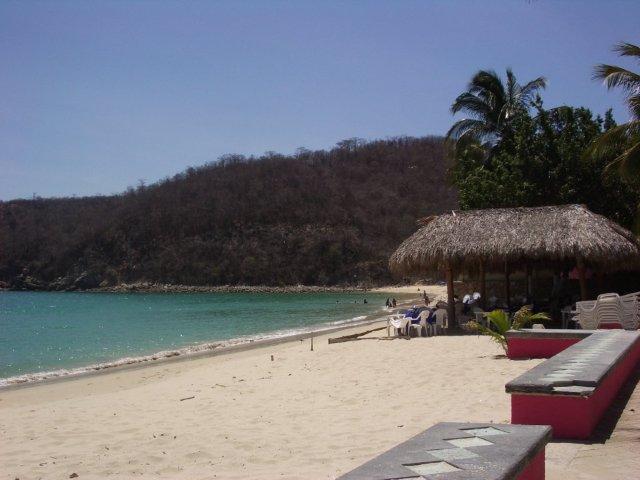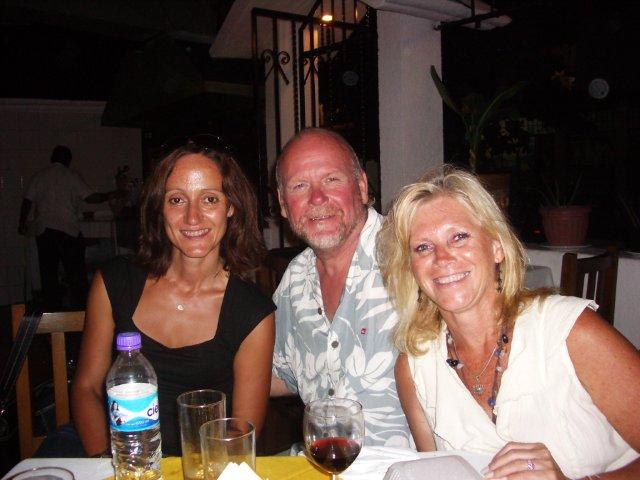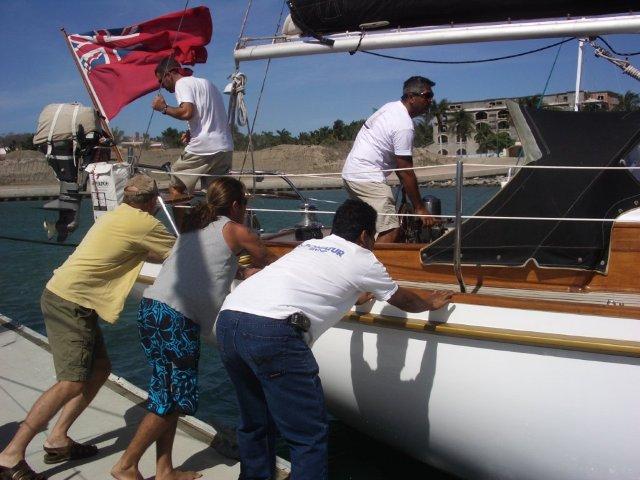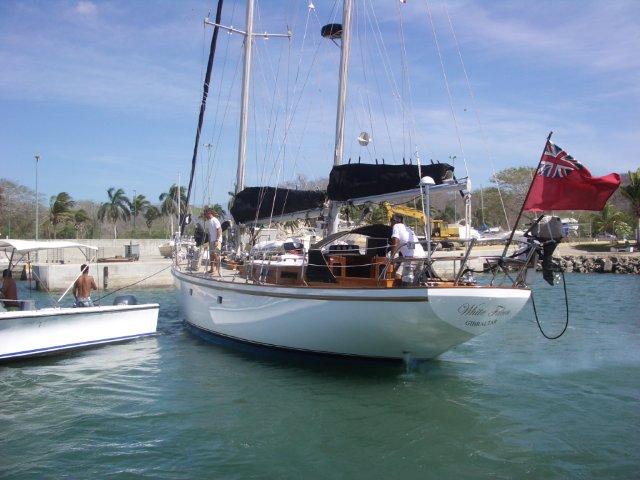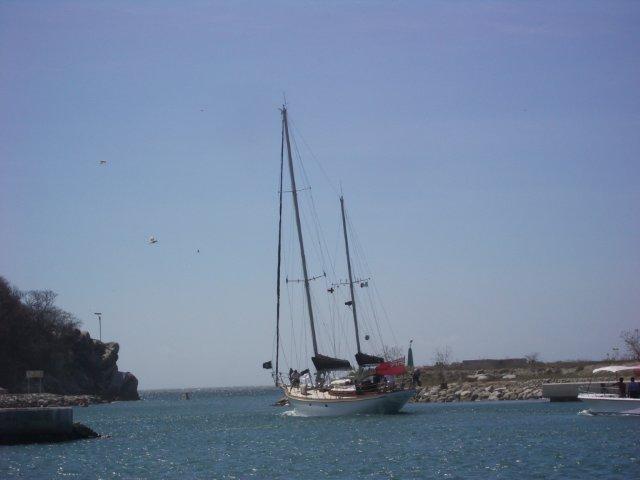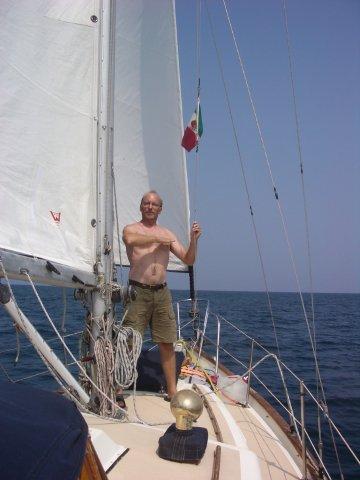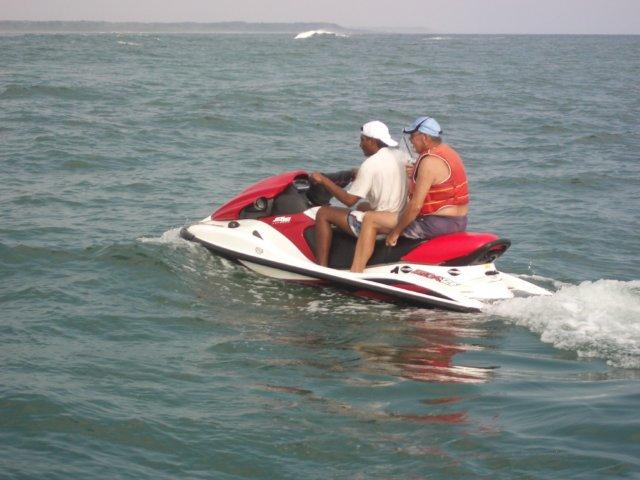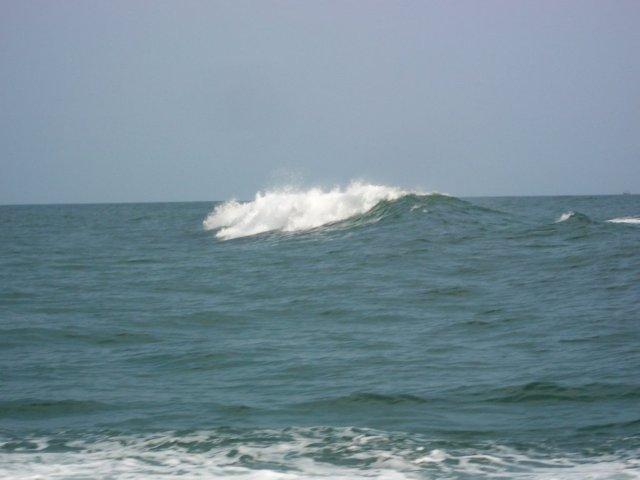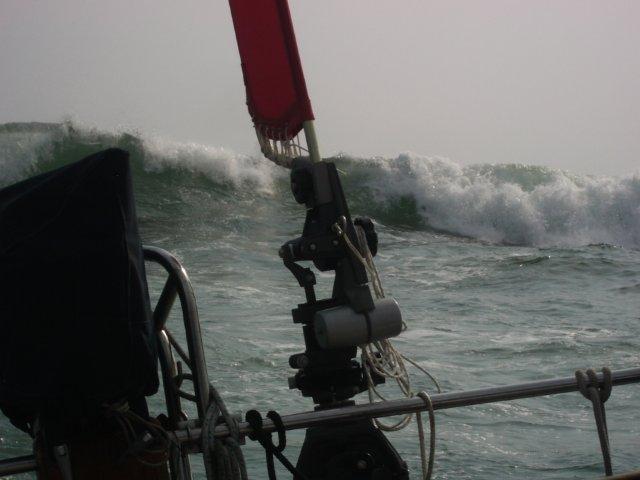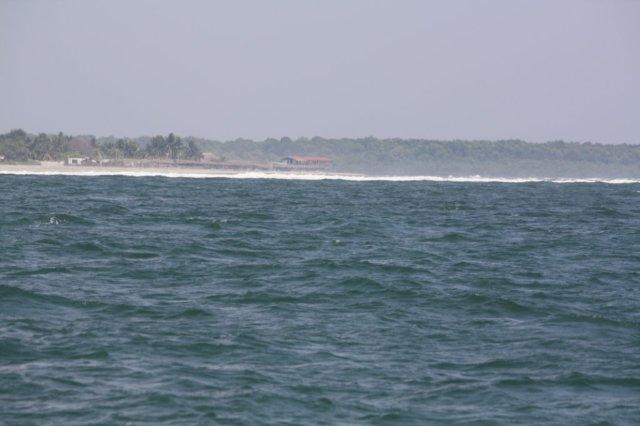Huatulco to Bahia del Sol - Crossing the Golf of Tehuantepec (Part 1)

|
Crossing the Golf of Tehuantepec I never thought I’d spend any time at all talking about
Huatulco, in the state of Oaxaca in Mexico . As a matter of fact, until I spent
time there, I couldn’t even remember the name. I kept calling it Hutalco
and had to constantly refer to our travel guide to remind myself of the proper
name. But our stop in Huatulco turned out to be as sudden a change of pace to
our trip as the abrupt 90-degree angle the land makes on the western edge of
Mexico’s Southern Coast, right where Huatulco is located. For Mayan people,
Huatulco is a pilgrimage place where allegedly the ubiquitous Mayan feathered
serpent god Quetzalcoatl made a rare appearance in person disguised as a
bearded white man. For historians, Huatulco is at the northwestern edge of
Mesoamerica, the cultural region extending approximately from Mexico City to
Honduras and Nicaragua, which was the home of Mayan civilization. For Eric and
me, Huatulco was where we would exit Mexico and take the big plunge across the
infamous stretch of water of the Golf of Tehuantepec down Central America. Other than the cruising info from Charlie’s Charts to
the Western Coast of Mexico, our cruising guide, the only thing we knew
about Huatulco was that it is the place where cruisers stop at to wait for a
weather window to cross the Golf of Tehuantepec. The thought of crossing the
Tehuantepec was sufficient in and by itself to occupy our minds entirely and
feed our imagination about the place as we were approaching it. But nothing
could have prepared us for the unexpected weather phenomenon we encountered
upon our arrival in Huatulco. After 36 hours of smooth downwind sailing since
we had left Acapulco, we were faced with 30 knots of head wind very shortly
after we made the 90-degree turn onto Mexico’s southern coast toward Huatulco.
An hour or so still away from Huatulco, we turned on the engine after almost 36
hours of engine-free sailing mostly in the hands of Hydro-Dave. This surprising greeting by a local weather system upon our
arrival in Huatulco immediately gave us a taste of the kind of conditions we
would have to learn about during our stay there and made crossing the
Tehuantepec seem so much more ominous. As we approached the dock at Marina
Chahue where we had reserved a slip, there were a dozen people on the dock around
our slip waiting to catch us in flight. This reception committee to help us
dock in the current weather conditions was representative of the camaraderie
that exists among the cruisers in Huatulco. Quoting from Charlie’s
Charts, “Because of the long distances between the few harbors
available and the intimidating and well-deserved reputation of the Gulf of
Tehuantepec, few cruisers sail these waters for pleasure. Those who pass this
way do so because they are heading to or from the Panama Canal or are sailing
for other offshore destinations.” We did get to know some very nice folks
while there with the same goals of going south as us. Some folks we had met
earlier on but not run into again for a while. Some others we didn’t know
but they knew other boats we had met earlier too. We exchanged boat cards (that
is personal cards with boat names and personal contact info) and made
open-ended plans to meet again halfway around the world. For the first time
since we started on this adventure, I felt I sense of belonging to a community,
not to a community in the traditional sense, but to that floating community
spread across the planet. It was exhilarating! While in Huatulco, we were able to discover the treasures of
Oaxacan cuisines. We had dinner in a couple local favorites in the town of
Crucecita and enjoyed the evening atmosphere in the local Zocalo (the central
public square common to each Mexican town). We also enjoyed provisioning in one
of the locally owned small stores which had the most beautiful display of fresh
produce, meats, artisanal cheeses and coconut-flavored confections I’ve
seen in my entire time in Mexico and which could rival small gourmet stores in
the US. We also spent time on a popular local beach in the town of Santa Cruz. This New York Times article
from a few years ago gives you a good sense of what our experience of Huatulco
was like. But most of our time there was spent planning our departure. Huatulco
was our last Mexican port. So we had to check out of Mexico with the local
authorities and get an international Zarpe, which is the official Latin
American name of the document required to enter a new country after leaving
another one. We also had to keep an eye on the weather and figure out how to
identify good weather windows to cross the Tehuantepec. After discussing the
matter with the marina employees upon checking in, we were informed that
Enrique, the marina employee and local weather celebrity who had been guiding
cruisers like us through the Tehuantepec for the past 6-7 years was no longer
working there. We also found out that a few boats had left to cross the
Tehuantepec during the last weather window a couple days before we arrived and
that the next pack of boats planning to buddy boat across the Tehuantepec were
not leaving for another couple weeks. We came to the realization that if we
wanted to cross the Tehuantepec sooner than later we were on our own. A couple days after our arrival, after looking at the weather
forecast a few times a day, we started seeing a weather window opening a couple
days out. So we started setting things in motion to check out with the local
authorities and plan a departure for then. In the meantime, we talked with
people in the marina who had crossed the Tehuantepec before or were planning to
do so imminently to confirm our analysis of the forecast. One set of people we
checked with was Eric and Sheryl of sailing vessel Sarana who have written a
cruising guide to Central America (similar to Charlie’s charts) which we
happened to own and was going to be our main source of info for cruising all
the way to the Panama Canal. Sarana had just made the Northbound trip across
the Golf of Tehuantepec and arrived in Huatulco a few weeks prior returning
from a season in South America. It was nice to meet them in person and get
additional info about cruising Central America in general. We spent
Saturday afternoon preparing for departure. Crossing the 250 miles of the Golf
of Tehuantepec takes about 2 ½ days. The weather window was approximately 3
days at that point. We couldn’t wait to go if we wanted to have a little
bit of safety room. After getting all the validation we could from the folks on
the dock while waiting for an appointed visit to our boat by the local
authorities at 6pm as we had indicated to them that we wanted to leave that
night, we decided to cast off right at sundown in whatever was left of the
daylight. After so much anticipation, crossing the Tehuantepec was the most
uneventful leg we’ve had so far on this trip. We decided to follow the
recommended approach to follow the coastline all the way down the Tehuantepec
with one foot on the beach, that is in no more than 30 to 60 feet of water or
approximately ¼ mile to 2 miles offshore at most all the way down the coast. By
following this strategy, if you get caught in a blow, all you have to do is
drop anchor and ride the blow so you don’t get blown offshore where the
seas get really big. When we left Huatulco around 7:30pm on Saturday, the seas were a
little confused and remained as such for a few hours before flattening out
later that night as a result of the last blow which had just ended earlier that
afternoon. But the winds were as forecast: NNE 5-10 knots. This was a little
unnerving at first as it also happens to be the direction from which a
Tehuantepecer wind blows. But the winds remained under 10 knots with gusts at
12-13 till sunrise. During the day, it shifted to SSW 5-10 knots till sunset.
This remained the day/night pattern for the next couple days. There were times
when we could have sailed and turned off the engine. But we kept the engine on
the whole way from Huatulco to Puerto Madero. Being alone in the Golf of
Tehuantepec is a little unnerving. We passed Salina Cruz, the first port 60
miles south of Huatulco, at around 7am the next morning and rounded up Puerto
Madero 250 miles south of Huatulco at 7pm the next day exactly 48 hours after
leaving Huatulco. We were officially out of the Tehuantepec! After Puerto Madero we picked up some positive currents that
kept pushing us and helped us maintain an average of 6.5 knots for the rest of
our trip. We entered Guatemalan waters and said goodbye to Mexico around 9pm
that night. The Guatemalan coastline was lit by electrical storms that went on
all night that night. Around 2am, we passed through a small rain squall that
rained on us for a few minutes at most. The next morning during my shift I
passed a pod of Guatemalan shrimpers in their pangas. It was a very comforting
sight for me confirming that the good weather forecast was holding as shrimpers
only go out when the weather is nice. Of course, I only needed to look around
me to know the weather was nice. We were in doldrums: no waves, no wind, seas
as flat as a pancake. It was hard to imagine it was the same ocean that could
turn into a monster in a matter of just a few minutes just a few miles north of
us. That night we crossed into Salvadoran waters. The next morning around 9am
we arrived at Bahia del Sol, El Salvador, approximately 84 hours after leaving
Huatulco. It is difficult to make that leg in any better time than that. We
were thrilled by the whole experience and couldn’t believe our luck
crossing the Tehuantepec this easily on our own! Crossing the bar at Bahia del Sol We originally had not planned on stopping at Bahia del Sol. When
we first mapped out our itinerary south of Huatulco back when we were in Puerto
Vallarta we thought conservatively that we would need to have contingency stops
to get some rest after we crossed the Tehuantepec in case we got caught in a
blow. Our original plan had us stop contingently in Puerto Madero, Mexico in
the case of a blow or in Puerto Quetzal, Guatemala if things went well in the
Tehuantepec and then from there in Barillas, El Salvador. But once we got to
Huatulco, we were told it is cheaper and easier to check out of Mexico in
Huatulco. We were also warned of the risk of having to check out of Mexico
again, even if we just anchored outside of Puerto Madero for the night. We also
heard rumors that the Guatemalan authorities in Puerto Quetzal were not
friendly to cruisers. So we decided to bypass Puerto Madero and Guatemala
altogether. Finally, since we had to make it all the way to El Salvador, we
were told Bahia del Sol could potentially be a good option for us to stop
depending on what time we arrived because it is 60 miles north of Barillas
therefore making our trip from Huatulco a little shorter. We also found out
that it was a planned stop for most of the boats that left Huatulco as part of
the newly created Zihuatanejo to El Salvador rally organized by Bill and Jean
of sailing vessel Mita Kuulu, whose card we had been handed out during the Baja
Ha Ha rally. So in other words, all the cool kids were going from Huatulco to
Bahia del Sol. Why don’t we just go there too? As it turned out, we
arrived at Bahia del Sol at 9am, 3 and ½ days after leaving Huatulco. It seemed
like a good time to pull in. So we radioed Hotel and Marina Bahia del Sol and
asked for permission to come in. Jean of Mita Kuulu answered our call. She said
the crossing of the bar at Bahia del Sol could only be made at high tide which
was at 3:30 that afternoon and if we could anchor out by the beach and wait for
the pilot to come help us across the bar at that time. So we spend the day at
anchor by the beach at Bahia del Sol. At around 3pm, we got a radio call from Bill of Mita Kuulu that
he was on his way with the pilot on a jet ski to come get us and could we meet
them outside of the bar. Eric and I lifted anchor and proceeded to rendezvous
the jet ski. Soon, we received instructions from the pilot. When ordered to do
so, Eric turned the boat facing in the direction of the waves and when the
first big breaker wave started forming behind us, he was told to rev up the
engine as high as he could and go with the wave. The boat surfed the wave beautifully and we were told to hold
our position for the next wave that would be forming behind us and to repeat
the same process. The second wave would push us across the bar and we would be
in. Precisely at that moment, our engine alarm went off indicating the engine
was overheating. We obviously were not in a position to turn it off. So we
waited for the second breaker wave to push us in front of the bar a few seconds
later. At that point we were no longer at risk to roll in the breakers or over
the bar, but the conditions were still rolly. So Eric decided to keep the
engine on and asked me to pull the foresail out since we were downwind. We kept
the engine on for a few more minutes and when it was confirmed we could sail
our way in the bay and that a couple dinghys would come help us dock, Eric
turned off the engine. We made it to the dock under sail and as promised we
were guided by a couple dinghys and made it safely into our slip. But needless
to say that our engine failure was a hard blow especially after the morning
excitement of having made it across the Tehuantepec with flying colors. Our stay at Bahia del Sol, while certainly tainted by the
unplanned circumstances under which we arrived, would most likely not have been
as enriching as it was had those circumstances not been part of the experience.
Let me explain. After we pulled into our slip at the marina and tied up to the
dock, Eric took a futile look into the engine room to confirm what we already
suspected: 1. Various fluids including coolant and water had spilled out of the
engine and sprayed all over the engine room. 2. The engine and engine room were
too hot for us to get anywhere near them for a few hours. Add to that that we were pretty tired after 3 and ½ days at sea
and a ½ day at anchor. Troubleshooting what happened to the engine was not
going to happen till the next day at the earliest. Bahia del Sol was our first port of entry into El Salvador. So
while tired, we still had to busy ourselves with visiting the local authorities
office to check into the country. Luckily, immigration keeps an office at Hotel
Bahia del Sol. And since we were expected since morning, the immigration
officer came to us instead of us having to go to them. So it didn’t take
too long to check in. In the meantime, plans were being made for us on the dock. When
we arrived in the marina, one of the people who greeted us at the dock and
helped us handle the dock lines was Vicki of Inspiration at Sea with whom we
had spent a couple months in La Paz and whom we had run into again in Huatulco
the day we arrived and just one day before she left Huatulco to cross the
Tehuantepec. We knew she was going to Bahia del Sol. We also knew that she and
her husband Rudy who was visiting were planning to tour the area and we thought
for sure they would have already left when we arrived. But very lucky for us,
they had made all the arrangements with another couple John and Gayle of Siren’s
Call for a 3-day guided tour of Mayan sites leaving on the next day and the
next thing we know the 4 of them are inviting us along. We agreed to join them
and departed the next morning at 8am on a tour of Mayan ruins in El Salvador
and in Copan in Honduras and of the colonial town of Antigua in Guatemala. The
tour has become one of the highlights of our entire trip so far. (Photos
following in my next post.) Upon our return from our 3-day excursion, we finally got around
to troubleshooting our engine. A quick inspection exposed the following issues:
the hose for the raw water intake on the heat exchanger had come loose when the
engine was revved up causing the water cooling cycle around the engine to break
and the raw and fresh water cooling systems in the engine to overheat quickly.
As a result pressure had built quickly in the engine causing two additional
problems: the cap on the coolant overflow container which was loosely screwed
blew off and intense pressure in the raw water output overflow container (also
known as a waterlock) blew up a hole the size of a golf ball in the middle of
it causing water and exhaust fumes to come out through the whole into the
engine room. To add more complication to an already messed up situation, a few
thorough searches of the engine room did not produce the missing cap that blew
off the coolant container. Did it come out of the engine room in one of our own
hands the day of the engine overheating incident? Neither one of us had any
recollection of it. Madness I’ll tell you. In a whole hierarchy of engine
parts, the radiator cap and the water lock would not be considered critical
components of the system. But in our situation they proved to be rather
necessary to replace: the engine could not be operated with coolant in the coolant
container being uncovered and with water and exhaust fumes leaking into the
engine room. A pursuit of the option to replace the waterlock quickly revealed
that there were no such marine parts available in the country. A suggestion to
contact a hardware store in San Salvador to have the part imported quickly
turned into a realization that it wasn’t easy to import anything into the
country. An investigation with local boat maintenance staff in the marina
indicated we would have to make a trip to an auto part store in San Salvador to
locate a radiator cap to replace the missing one on our engine coolant
container. But after a day roaming all the new and used auto part stores in San
Salvador, we discovered that in a capital city the size of a small American
town which was struggling to produce enough food to feed its own people and
have enough inventory to cover the local population needs, our non-standard
oversized radiator cap was not going to be available anywhere in town. So we
came back to the boat realizing we would need to pull some McGiver tricks to
get the boat back under way. The top of a jar of Classico tomato sauce was
repurposed as an interim radiator top and fastened to the coolant container
with a large clamp, the kind you use to fasten a rubber hose to a pipe. The
hole in the waterlock was patched with a piece of plywood found in the landfill
of a local ferreteria (hardware store) cut to size and covered in bondo under
some more layers of bondo. The final result looked like the waterlock had been
patched with a whole bunch of bubble gum and would have made McGiver very proud
of us. After a few hours of drying time, we put the waterlock back on and ran a
leak test by starting the engine. We only had a couple dripping spots on the
bondo work which we thought would potentially disappear when the bondo expanded
under heat when under way. So we considered our engine repair work done and
hoped it would hold us till Panama where we would get replacement parts. In the meantime, we had been at Bahia del Sol long enough for
the next pack of boats coming from Huatulco to have arrived while we were
repairing our engine. One of them, Dolce Vita, had arrived in Huatulco a couple
hours after we did and was moored on the dock right next to us in marina Chahue.
In the 4 days we had spent in Huatulco, we had become very well acquainted with
Dennis, Dolce Vita’s owner and Oriol, his crew from Barcelona who had
helped him bring the boat all the way from Puerto Vallarta to El Salvador
across the Tehuantepec. While we left Huatulco we had assumed we would not see
them again. But destiny had other plans for us in store. We were thrilled to
see them again when they pulled into Bahia del Sol. Both Dennis and Oriol
helped us with the final stages of our engine repair work. And in the following
couple days, as we were going through the usual motions of preparing for
departure, including provisioning and checking out of the country with the
local authorities to get our exit paperwork in order, we discussed with Oriol
having him come with us for our next leg to Costa Rica. We made official
arrangements to have him join us as a crew on board Pacific Mystic. Dennis had
told Oriol he needed him to get across the Tehuantepec and that he was free to
stay or go if he wanted after that. Dennis was planning on making Bahia del sol
a home base to explore Central America for a few months. Oriol decided to go on
further south to explore the surfing beaches of Nicaragua and Costa Rica. So he
loaded his surf board and couple bags onto Pacific Mystic. While we were going through the final preparations before
departure, one last bit of local drama unfolded. As we asked the marina for
permission to fuel, we were told there was a fuel shortage in the entire
country and we wouldn’t be able to get fuel until further notice, which
could be as long as a week to 10 days till the next tanker arrived. But of
course, this doesn’t apply to people who are well-connected in the
country. A conversation with the hotel owner resulted in a call to his brother in
congress and a special delivery of 2 barrels of diesel fuel reserved to Pacific
Mystic the next morning. Not sure whose list our names ended up on. But I can
now say I bought fuel in a barrel, how cool is that? And hey, we got our fuel.
Well, with one last hurdle. By the time our fuel arrived the next morning, the
word of the fuel shortage had gone around the marina and the content of our 2
barrels had been sold several times over. We had to watch our 2 barrels very
protectively until we were able to make it to the fuel dock with our boat. I
now understand how civil unrest can be started over a couple barrels of fuel.
Life is different in this part of the world. Bittersweetly so though, as
despite all our tribulations, I truly loved El Salvador and its people proudly
wearing their hearts on their sleeves. All the local drama was able to unfold and resolve itself in
time for us to leave within the weather window we had seen was opening for the
next few days. The last constraint for us was to wait for high tide the next
day at 6am to cross the bar out of Bahia del Sol. The local authorities
insisted on checking us out at 5am just before our departure. The exit
paperwork is only good for 24 hours within which the boat must leave the
country. So they don’t like to hand it out too much before planned
departure time. At 5:30am, Zarpe in hands and our 3 passports in order, Eric,
Oriol and I met our pilot on the dock. After a final inspection of the engine,
we cranked it up and followed the pilot jet ski out of the marina and toward
the bar a mile or so out. As we were making our approach to the bar, still about ½ a mile
away, our engine alarm went off again. Luckily, we were still inside the bar.
We turned around and motioned at the pilot that we were going back to the
marina. We also radioed Bill of ‘Mita Kuulu’ to let him know of our
engine (again) troubles and ask him if he could please give us a hand to dock
with his dinghy again. We returned to the dock a bit demoralized but not too
surprised and definitely curious about what this new challenge was about. We
were sure we would find out soon. While Eric had successfully restarted the engine after the
previous repair work, we suspected the problem still resided with the water
cooling systems. He decided that after letting the engine cool off for a little
while, he would do a meticulous inspection of every part connected to the water
cooling system directly or indirectly and bleed the entire system of all
potential air trapped within it, and tighten a few nuts and bolts in the
process. By the time we got back to the dock of course we had caught the
attention of all the boats around us. Within an hour of our return, we had 4 or
5 bodies bent over the engine room. It appeared we were in good hands so I
decided to go for a walk around the resort. When I returned a couple hours
later, the engine was running again in what seem a healthy form. From the
activity and loud exchanges between the guys on and off the boat I gathered
they had been running a load test on the engine and were coming to the
conclusion that the problem was resolved. Eric turned off the engine and some
loud chatter and cheers were exchanged on the way to the marina bar. It was
agreed we were ready to go the next day at high tide, same time. Our exit paperwork
would still be good. The weather window was still good. Arrangements were made
with the pilot to guide us through the bar the next morning. The next morning we repeated the same process as the day before,
minus the visit with the local authorities. As we were approaching the bar
behind the pilot jet ski, we all felt a little anxious and held our breath when
Eric revved up the engine to get across the breaker waves. Other than getting a
little water in the cockpit when one of the waves broke over the port bow as we
were passing the bar, we made it to the outside of the bar without any issue. I
announced our success over the radio amidst loud cheers on the boat and on the
dock. I spent a few minutes regrouping and got this strong feeling of
renewed confidence in our engine’s good health and suddenly realized what
the lesson with the overheating engine had been about. Remember my blabber
about sea gods teaching us lessons in my previous log entry? We had made it all
the way from La Paz to El Salvador without double-checking the engine work done
by our mechanic in La Paz. Well, you obviously can’t have a distant
relationship like that with your engine. You have to be one with it.
That’s what all that time in El Salvador was about. And better to have it
happen in El Salvador than during the Panama canal transit. We are now one with
the engine. I suddenly felt like we were in much better shape to get across the
Panama canal. But one step at a time. For now, we are on the way to Costa Rica. Here are a few pictures taken since my last post (from our
arrival in Huatulco to our departure from Bahia del Sol) Huatulco: 3/8/2010 – 3/13/2010
The beach in Santa Cruz, Oaxaca
Dinner with Jeff and Judy of ‘Island Mistress’ at
Kristal Rose, a local popular asadero (steakhouse) in Crucecita, Oaxaca Jeff and Judy are from South Dakota and know many folks we met
earlier in our trip Helping Andreas of ‘White Falcon’ (at the helm)
leave the dock in Huatulco ‘White Falcon’ was the beautifully restored 1960s
65-foot classic sailboat moored a couple slips from ours in Marina Chahue. ‘White Falcon’ left the day after we arrived. The
winds were still blowing at 25+ knots!
Eric, Oriol and a marina Chahue employee are giving ‘White
Falcon’ a push from the dock…
…while on the other side a panga is helping it pivot away
from the dock and into the wind.
Eric is watching the nicely done job from the dock: ‘White
Falcon’ is free!...
…and ready to beat into the weather in the Golf of
Tehuantepec seen past the point. Look at how much ‘White Falcon’ is heeled over
already without any sails up! Between Huatulco, Mexico and Bahia del Sol, El Salvador:
3/13/2010 – 3/17/2010
Guatemalan shrimpers off the Coast of Guatemala just south of
the Golf of Tehuantepec on the border with Mexico (Look at how glassy the Pacific Ocean is!)
Eric, retiring the Mexican courtesy flag after we entered
Guatemalan waters
Valerie, celebrating the successful crossing of the Tehuantepec
with a deck shower Crossing the bar at Bahia del Sol
Waiting for Bill’s instructions behind the pilot on the
jet ski…
Turning the boat in the direction of the breakers
Surfing the big breaker wave that pushes us across the bar
We’re in! View of the beach after we crossed the bar |
